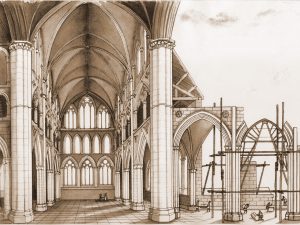 There is a long tradition of architectural research in structures—one thinks of Nervi, Candela, Torroja, and Frei Otto, the pioneers of concrete like Perret, and much earlier the Byzantine and Gothic builders. Architects have sometimes experimented successfully with new building techniques and materials (Rudolph invented striated concrete blocks; Foster was the first to use structural glass fins). But research into how people use buildings is rare. The profession has always recognized the value of so-called post-occupancy evaluation, and the need for knowledge based on how people actually behave in and use buildings. The problem has been that this kind of research is extremely complicated, time-consuming, and expensive. Moreover, it fits into practice with difficulty. There is no advantage to a practitioner in showing the long-term deficiencies of his design decisions. Negative feedback is merely embarrassing. There is a professional reluctance to “tell tales out of school” and to reveal clients’ confidences, or to suggest that what the client got was less than perfect. A scientist can publicly document experiments that failed without risk—indeed, that is the basis of the scientific method—but an architect’s reputation would suffer were he to do so. (I learned about this when I wrote The Biography of a Building, about the Sainsbury Center for Visual Arts.)
There is a long tradition of architectural research in structures—one thinks of Nervi, Candela, Torroja, and Frei Otto, the pioneers of concrete like Perret, and much earlier the Byzantine and Gothic builders. Architects have sometimes experimented successfully with new building techniques and materials (Rudolph invented striated concrete blocks; Foster was the first to use structural glass fins). But research into how people use buildings is rare. The profession has always recognized the value of so-called post-occupancy evaluation, and the need for knowledge based on how people actually behave in and use buildings. The problem has been that this kind of research is extremely complicated, time-consuming, and expensive. Moreover, it fits into practice with difficulty. There is no advantage to a practitioner in showing the long-term deficiencies of his design decisions. Negative feedback is merely embarrassing. There is a professional reluctance to “tell tales out of school” and to reveal clients’ confidences, or to suggest that what the client got was less than perfect. A scientist can publicly document experiments that failed without risk—indeed, that is the basis of the scientific method—but an architect’s reputation would suffer were he to do so. (I learned about this when I wrote The Biography of a Building, about the Sainsbury Center for Visual Arts.)
It would require a sort of unbiased consumer protection agency to do true post-occupancy evaluation. But who would fund it? Not the original designer, whose reputation can only be hurt. Not the client, who may be criticized for misuse of funds. Not the building industry, which may be legally liable for deficiencies. Not the current building owner who will only risk reaping bad pubicity. A government-funded consumer agency seems like a long shot in the current climate. The most likely areas for intensive research into human behavior in buildings would be focused on specific subjects of vital public concern: thermal comfort related to energy conservation, crowd behavior in building disasters, the health effects of healthcare environments.
What is the alternative? In the past, architects were relatively conservative when it came to innovation. Palladio researched archaeological ruins, and innovated in formal aspects of building, but the plans of his villas follow tried and true models. Architects based their work on a Canon—buildings that were considered exemplary and provided field-tested models. I have many friends who are “traditionalists” and “classicists.” What distinguishes their work from that of the self-styled avant-garde is that they tend to lean on historic precedent and traditional types for design decisions, rather than conjuring up novel forms and building arrangements out of thin air. This is true both in building design and urban design. Slow and steady wins the day.
